
Trischaken is an historical Austrian, German and Polish gambling card game for three to five players. It appears related to French Brelan [1] and German Scherwenzel.

Trischaken is an historical Austrian, German and Polish gambling card game for three to five players. It appears related to French Brelan [1] and German Scherwenzel.
The game dates back to the 16th century when it was played at court in the Kingdom of Poland. It is also mentioned as a card game in a 1706 German poem [2] and listed as a banned gambling game in a 1734 law book of Anhalt-Bernburg. [3] An indication of its distribution is given by its inclusion in a 1771 Bremen-Lower Saxon dictionary [4] and its description as "popular" in Bavaria from at least the late 18th [5] to mid-19th century. [6] The word was also spelt dreschaken, meaning "to beat, thrash, cudgel", [6] and may have been derived from dreschen, to thresh, recalling the game of Karnöffel whose name also means "to thrash". [7] In 1871 it was described as a game of chance, popular with peasants "in the provinces" and played with the "large old German cards", which presumably meant 36- or even 48-card, German-suited packs. [8]
Treschaken was equated with French Brelan and the game of Krimp, Krimpen or Krimpenspiel. [1] [9]
The Brothers Grimm give a brief description of Drischaken as a game for three to five players in which each receives 3 cards and the winner is the one who has the most cards of various possible combinations. They give various alternative spellings as drischäken, drischeken, dreschakn, trischaken and trischakeln. and adds that, "likewise karnöfeln means playing as well as thrashing", referring to another widespread card game of the time. [10]
A detailed description in German of the rules of Brelan (aka Trischaken) is given in Pierer's Universal Lexikon, Volume 3 in 1868. [11]
According to Popowitsch (1705–1774), the Austrian game of Trischack (Trischackspiel) was played with 3 cards and the Jack (Bub) or Nine – known as Pamfili – of each suit are wild. In Saxony and Silesia, they were called Wenzels or Scharwenzels. Thus it may have been related to the Bavarian game of Scherwenzel. However, Hommel equates Trischak to Grobhäusern which was essentially Scherwenzel without any wild cards. [12]
In Austria, the Schärwenzel (i.e. the 7, 8 and 9 or the 7, 8 and Jack) was the highest card. In Franconia and Saxony, Trischaken was played with 4 cards per player using German-suited cards. [13]
Tryszak (German: Treschak [14] ), also called Straszak and Fluss because a flush was an important feature, was an old gambling game that was popular at the beginning of the reign of Stanisław August Poniatowski (reigned 1764–1795), but had been attested much earlier since there is a story that when King Sigismund I (reigned 1506–1548) was playing the game with two ministers, he was dealt two Kings but did not have a third one in his hand. So he claimed that he counted as the third king and thus ensured he won. [15] A detailed description of the game is given by Chomentowski and reproduced by Łukasz Gołębiowski (1831). [16]
The game was played thus: a silver plate was placed on the table and each player laid his money in front of him and anted a stake to the plate. A pack of 36 German-suited cards was shuffled and the dealer dealt two cards each. Obers and Nines were better than the others and could be used as wild cards to make up a triplet or quartet. After the deal, if a player had poor cards and couldn't form a pair, they were discarded. A player with a Nine, an Ober or a pair, passed, waiting for someone to say "play", then replied "I'll keep it". Those left in would play; out of 6 to 9 players, often only 2 or 3 would play. A bold player or one with good cards could raise the stake before the next two cards were dealt. A player decided how many cards he wanted to exchange, raising the stake each time. The aim was to scare the opponent into folding and, with a poor card or a good one, force the stakes up. However, if no-one wanted to take a risk, the rate was suddenly reduced and returned to the basic stake. [16]
The cards ranked in the typical order for Polish cards. Four-card combinations ranked above 3-card combinations; a straight flush outranked a flush which, in turn, beat a set (triplet or quartet). Obers and 9s were wild; one wild card could be used to make up a 3-card combination and up to two could be used to make up a 4-card combination. Natural combinations outranked wild combinations of the same type; likewise three Kings outranked three Obers etc. [16]
Tryszak may be ancestral to Chlust which has been known since the early 19th century.[ citation needed ]
Schmidt suggests an actual link with Karnöffel as well as a game called Treschack, played with 3 Kings (It.: tre sciacchi), neither of which resemble Brelan. [1]
In modern times, Trischaken is the name of a null contract in the popular European Tarot card game of Königrufen.
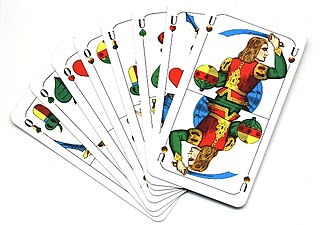
Schafkopf, also called Bavarian Schafkopf, is a popular German trick-taking card game of the ace–ten family for four players that evolved, towards the end of the 19th century, from German Schafkopf. It is still very popular in Bavaria, where it is their national card game played by around two million people, but it also played elsewhere in Germany and in Austria. It is an official cultural asset and important part of the Old Bavarian and Franconian way of life. Schafkopf is a mentally demanding pastime that is considered "the supreme discipline of Bavarian card games" and "the mother of all trump games."

Karnöffel is a trick-taking card game which probably came from the upper-German language area in Europe in the first quarter of the 15th century. It first appeared listed in a municipal ordinance of Nördlingen, Bavaria, in 1426 among the games that could be lawfully played at the annual city fête. This makes the game the oldest identifiable European card game in the history of playing cards with a continuous tradition of play down to the present day.
Elfern or Elfmandeln, is a very old, German and Austrian 6-card, no-trump, trick-and-draw game for two players using a 32-card, French-suited Piquet pack or German-suited Skat pack. The object is to win the majority of the 20 honours: the Ace, King, Queen, Jack and Ten in a Piquet pack or the Ace, King, Ober, Unter and Ten in a Skat pack. Elfern is at least 250 years old and a possible ancestor to the Marriage family of card games, yet it is still played by German children.
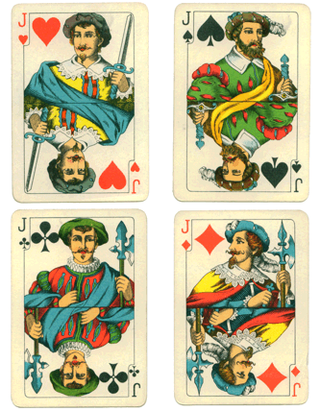
Grobhäusern, also Grobhaus, is an historical German vying game in which players bet and then compare their 4-card combinations. It is played by two to eight players using a 32-card piquet pack. The game was illegal in most places. It was popular in rural Upper Saxony in the late 18th century. A variant played in Danubian Austria-Hungary was Färbeln.
Scherwenzel or Scharwenzel is a 16th century, German, gambling game played with cards and named after the Unters or Jacks that had special privileges. It appears to have been an elaboration of Grobhäusern or Färbeln played in Germany, Poland, Silesia and Bohemia, but especially in Bavaria in which the Unters were variously known as Scharwenzels, Scherwenzels, Scherers or Wenzels. They, and to some extent also the Nines, functioned as wildcards. According to Adelung, Grobhäusern, on which it was based, was "far simpler than Scherwenzeln".

German Solo or just Solo is a German 8-card plain-trick game for 4 individual players using a 32-card, German- or French-suited Skat pack. It is essentially a simplification of Quadrille, itself a 4-player adaptation of Ombre. As in Quadrille, players bid for the privilege of declaring trumps and deciding whether to play alone or with a partner. Along with Ombre, Tarock and Schafkopf, German Solo influenced the development of Skat. Parlett calls it a "neat little descendant of Quadrille" and "a pleasant introduction" to the Ombre family of games.

German Schafkopf is an old German, ace–ten card game that is still played regionally in variant form today. It is the forerunner of the popular modern games of Skat, Doppelkopf and Bavarian Schafkopf. It originated in Leipzig in the Electorate of Saxony. Today it is hardly ever played in its original form, but there are a number of important national and regional derivations.
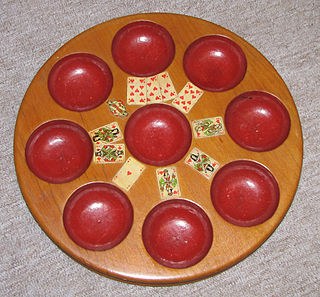
Poch, Pochen or Pochspiel is a very old card game that is considered one of the forerunners of poker, a game that developed in America in the 19th century. An etymological relationship between the game names is also assumed. Games related to Poch are the French Glic and Nain Jaune and the English Pope Joan. Other forerunners of poker and possible relatives of the game are the English game, Brag, from the 16th century and the French Brelan and Belle, Flux et Trente-et-Un. Poch is recorded as early as 1441 in Strasbourg. In north Germany it was called by the Low German name of Puchen or Puchspill, and the board was a Puchbrett.

Brandeln is an historical card game for three or four players; in which the winning bidder plays alone against the rest. It is one of the earliest games to use the terms Bettel – a contract to lose every trick – and Mord - a contract to win every trick. One of several card games mastered by Mozart, Brandeln is still current in Austria and Germany today. It has been described as having a "civilized, refined and ingenious character" and "one of the most pleasant card games".

Zwicken is an old Austrian and German card game for 4 to 6 players, which is usually played for small stakes and makes a good party game. It is one of the Rams group of card games characterised by allowing players to drop out of the current game if they think they will be unable to win any tricks or a minimum number of tricks. Despite a lack of sources, it was "one of the most popular card games played from the 18th to the 20th century in those regions of what is today Austria."

Binokel is a card game for two to eight players that originated in Switzerland as Binocle, but spread to the German state of Württemberg, where it is typically played with a Württemberg pattern pack. It is still popular in Württemberg, where it is usually played in groups of three or four as a family game rather than in the pubs. In three-hand games, each player competes for himself, while in four-hand games, known as Cross Binokel (Kreuzbinokel), two teams are formed with partners sitting opposite one another. The game was introduced to America by German immigrants in the first half of the 20th century, where it developed into the similar game of pinochle. Binocle was still played in Switzerland in 1994. In south Germany, the game is sometimes called by its Swabian name, Benoggl.
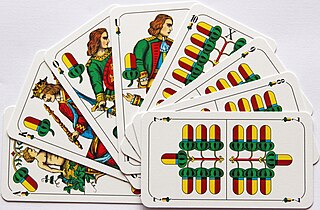
Wallachen is an Old Bavarian card game, which used to be very popular in eastern Bavaria. Although, by 2012, it had become a rarer sight at pub tables, there have been more recent moves to revive it. Wallachen is a relatively simple three-hander that is easy to learn. As a result, like Grasobern, it has a relatively relaxed character without the mental demands of Schafkopf or the psychological stress of Watten. It is a member of the Préférence family of card games.
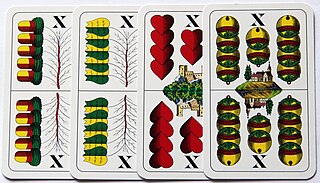
Matzlfangen is a traditional point-trick, card game for 4 players that originated in the Bavarian province of Upper Palatinate over 200 years ago and spread to Austria. It is still played in a few places today. The game is named after the ten or Matzl, which plays a key role.

Scharwenzel, formerly also called Schipper-Schrill, is a traditional north German plain-trick card game of the Schafkopf family that is played by two teams with two to four players on each team. The game is at least three centuries old and is played today only on the island of Fehmarn in the German state of Schleswig-Holstein. It may be a regional variant of German Solo with which it bears some similarities and it may also have been ancestral to Schafkopf. It is not related to a different game called Scharwenzel or Scherwenzel that was once played in Bavaria.

Officers' Schafkopf is a German point-trick card game for two players which is based on the rules of Schafkopf. The game is a good way to learn the trumps and suits for normal Schafkopf and to understand what cards one is allowed to play. It is similar in concept to Officers' Skat.
Spitzeln is an historical German card game for three players and a variant of German Solo.
Karniffel or Thuringian Karnöffel was a trick-taking card game for four players, playing in pairs, the rules of which were recorded in some detail in a German periodical of the late 18th century where it was described as being played by the Thuringian peasantry. Karniffel was a descendant of the original Karnöffel.

Drużbart or Druzbart is an extinct Polish card game of the Bruus family. The game is descended from the oldest known card game in Europe, Karnöffel, a fact testified by its unusual card ranking and lack of a uniform trump suit.
Neunkart or Fett und Mager was a traditional North German card game played with 36 French-suited cards.
Polish playing cards have been manufactured since the 15th century and include both French- and German-suited cards. Polish playing cards may also refer more narrowly to the Polish pattern: traditional packs of 36 German-suited playing cards produced in Poland to local designs.